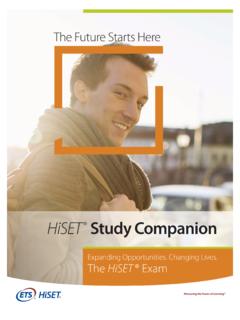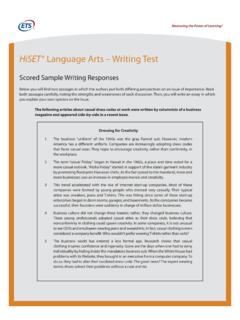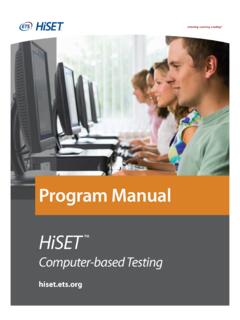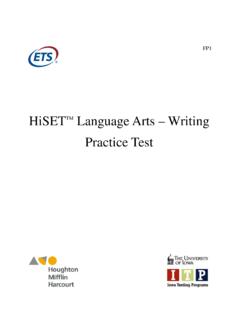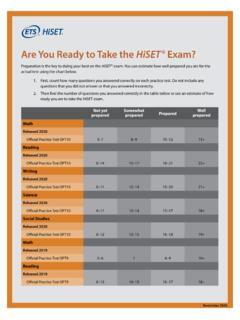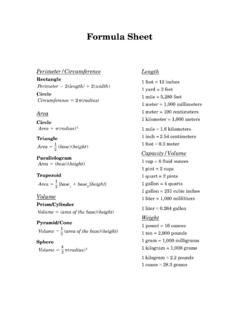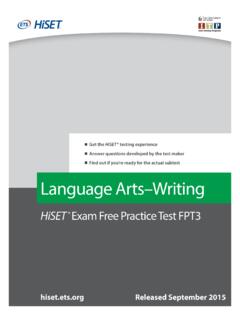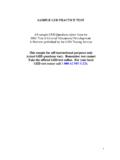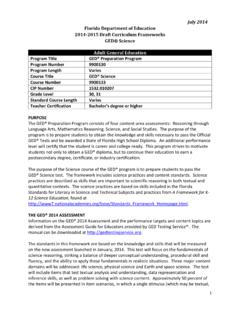Transcription of HiSET Science Practice Test
1 HiSETTM Science Practice TestFP1 Copyright 2013 Educational Testing Service. All rights reserved. E T S and the E T S logo are registered trademarks of Educational Testing Service (E T S) in the United States and other countries. HiSET is a trademark of E T S. Test items from THE IOWA tests OF EDUCATIONAL DEVELOPMENT copyright 2001, 2003, 2007 by The University of Iowa. All rights reserved. Used under license from Houghton Mifflin Harcourt. THE IOWA tests is a registered trademark of Houghton Mifflin Harcourt Publishing is a test of your skills in analyzing Science information. Read each question and decide which of the four alternatives best answers the question. Then mark your choice on your answer sheet. Sometimes several questions are based on the same material. You should carefully read this material, then answer the as quickly as you can without becoming careless.
2 Don t spend too much time on any question that is difficult for you to answer. Instead, skip it and return to it later if you have time. Try to answer every question even if you have to all your answers on the answer sheet. Give only one answer to each question and make every mark heavy and dark, as in this you decide to change one of your answers, be sure to erase the first mark sure that the number of the question you are answering matches the number of the row of answer choices you are marking on your answer sheet. GO ON TO THE NEXT PAGE -4-GO ON TO THE NEXT PAGE ScienceTime 40 minutes25 Questions GO ON TO THE NEXT PAGE GO ON TO THE NEXT PAGE -5-Directions: Questions 1 through 5 are based on the information bees have a sense of smell? Dr. Karl von Frisch investigated that question in the early 1900s with these two 1 Dr. von Frisch set up a table with several identical cardboard boxes with removable covers.
3 Each box had a small door hole for bees. Inside one box, he put a dish of sugar water that was scented with a fragrant oil. The other boxes he left empty. When the bees had explored the boxes for several hours, Dr. von Frisch saw that they could easily find the box with the fragrant sugar water, even when he switched the positions of the this training period, Dr. von Frisch prepared a set of clean boxes for the bees. He did not use any sugar water this time, but he did scent the inside of one box with the same fragrant oil used before. The bees would buzz around the doors of all these boxes, but they would only crawl inside the box with the training scent. Experiment 2 Dr. von Frisch trained bees to enter a box that was scented with an oil made from the skin of Italian oranges. After the bees were trained, he prepared a clean set of 24 boxes. He scented one box with the Italian orange scent and scented all the others with different oils.
4 Dr. von Frisch then recorded how many bees entered each box in five von Frisch repeated the last part of the experiment, comparing an additional 23 fragrances to the one made from Italian oranges. Out of the 48 boxes used in the two runs, the only boxes that attracted many bees were the Used in BoxNumber of Bees Entering Box in Five MinutesOil of Italian oranges (First run)205 Oil of Italian oranges (Second run)120 Oil of citron148 Oil of bergamot oranges 93 Oil of Spanish oranges 60 These were the only boxes scented with oils from citrus fruits, and to a human nose they smelled very much the same. GO ON TO THE NEXT PAGE GO ON TO THE NEXT PAGE -6- 1 What was the main reason Dr. von Frisch switched the positions of the boxes during the training sessions?A To allow the scent to spread over the entire tableB To eliminate the effects of wind directionC To make the bees rely only on a sense of smell, if they had oneD To make sure the bees could not lead each other to the correct box 2 Given the results of experiment 1, which of the following conclusions is most valid?
5 A Bees probably have a sense of Bees probably do not have a sense of Bees probably identify different kinds of flowers by Bees probably do not identify different kinds of flowers by smell. 3 The dependent variable in an experiment is the factor that is observed to see how it changes in response to the experimental variable. What was the dependent variable in experiment 2?A The number of bees entering a given box in five minutesB The presence or absence of sugar water in a boxC The length of time the bees were countedD The particular smell in a box 4 Suppose a bee s antennae can be coated with a material that prevents air from reaching them. If it was believed that a sense of smell in bees was located in their antennae, how could this idea best be tested?A Catch a bee, coat one antenna, and see if the bee can find any food in a field of flowersB Catch a bee, coat both antennae, and see if the bee can find any food in a field of flowersC Train a bee to find food in one scented box (as in experiment 1), then coat one antenna and see if the bee goes into a new box with the same scentD Train a bee to find food in one scented box (as in experiment 1), then coat both antennae and see if the bee goes into a new box with the same scent 5 How does the evidence gathered in the experiments relate to the following statement?
6 Bees can smell just as well as most The evidence proves that the statement is The evidence supports the statement but does not prove The evidence casts doubt on the statement but does not disprove The evidence disproves the statement. GO ON TO THE NEXT PAGE GO ON TO THE NEXT PAGE -7-Directions: Questions 6 through 9 are based on the information craters are formed when meteorites strike the surface of a planet. A researcher investigated some factors that might influence the formation of impact craters by either dropping marbles into a tray of sand or launching them from a slingshot into the sand. The results are shown in the table below. Test NumberMass of Marble (g)Method of Crater FormationMarble Speed (cm/s)Crater Diameter (cm)13 Drop from 2 from 2 from 10 from 2 from 36 cm3, 6 tests 1 and 2 were designed to test the effects of which of the following factors?
7 A The mass of the marbleB The speed of the marbleC The crater diameterD The method of crater formation 7 Which of the following statements best explains why the speed of the marble in test 5 is so much greater than the speed of the marbles in tests 3 and 4 ?A It was dropped from the greatest It was launched rather than It produced the largest It was made of a different material. 8 The observed difference in the crater diameters in tests 3 and 4 is most likely due to which of the following factors?A The mass of the marblesB The researcher s measuring techniqueC Whether the marble was dropped or launched D The height from which the marbles were dropped 9 Consider the results for tests 3, 4, and 5. Which of the following graphs best illustrates the relationship between marble speed and crater diameter? A SpeedDiameterB SpeedDiameterC SpeedDiameterD SpeedDiameterGO ON TO THE NEXT PAGE GO ON TO THE NEXT PAGE -8-Directions: The graph below shows the number of grams (g) of potassium nitrate (K N O 3) dissolved in 100 grams of water (H2O) at different Celsius temperatures ( C).
8 Use this information to answer questions 10 through 13. Grams of KNO3 / 100 g H2O1501401301201101009080706050403020100 0 10 20 30 40 50 60 70 80 Solubility of Potassium Nitrate (KNO3)Temperature C 10 Approximately how many grams of K N O 3 can be dissolved in 100 grams of H2O at 35 C?A 65B 60C 55D 50 11 Which of the following is the lowest temperature at which 70 grams of K N O 3 can be dissolved in 100 grams of H2O?A 55 CB 45 CC 35 CD 25 C 12 Which of the following is the best prediction of the mass of K N O 3 that could be dissolved in 100 grams of H2O at 70 C?A 105 gB 115 gC 135 gD 155 g 13 Approximately 80 grams of K N O 3 is dissolved in 100 grams of H2O at 50 C. If this solution is cooled to 10 C, approximately how much K N O 3 will come out of the solution?A 25 gB 35 gC 45 gD 55 g GO ON TO THE NEXT PAGE GO ON TO THE NEXT PAGE -9-Directions: Questions 14 through 20 are based on the information two experiments described below were done to investigate the effects of temperature on the growth rate of tomato IA group of 60 tomato seedlings (Group I) was grown in a greenhouse under controlled temperatures.
9 Ten plants were grown at each of six temperatures from 5 C to 30 C. These plants remained at their respective temperatures 24 hours each day for two weeks. All other conditions were the same for all seedlings. The growth rates are shown in Table 1. Growth rates for tomato seedlings in Group I Day/Night Temperatures ( C)Average Growth Rate (mm/day) 5 210 91515202025223022 Experiment IIA second group of 30 tomato seedlings (Group II) was kept at 25 C during the day (12 hours). However, during the night, three groups of 10 plants were moved to each of three different temperatures. All other conditions remained the same as in experiment I. The growth rates are shown in Table 2. Growth rates for tomato seedlings in Group IIDay Temperature ( C)Night Temperature ( C)Average Growth Rate (mm/day)251010252025253022 GO ON TO THE NEXT PAGE GO ON TO THE NEXT PAGE -10- 14 Which of the following is the best statement of the hypothesis being tested in experiment I?
10 A The optimum temperature for tomato seedling growth is 25 The temperature at which tomato seedlings grow must remain constant from day to The temperature at which tomato seedlings grow must vary from day to The temperature at which tomato seedlings are grown affects their growth rate. 15 Consider the following tomato seedlings were grown at constant temperatures of either 25 C or 30 C, their growth rates were the same. This statement is best described asA an an a a hypothesis. 16 The range of temperatures used in experiment I was most likely chosen for which of the following reasons?A They represent temperatures at which tomatoes can be They represent temperatures at which tomatoes are known to grow They represent temperatures that have not been used in previous They represent the only temperatures that can be controlled in a greenhouse.
